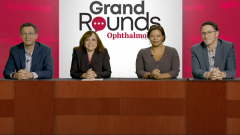
Approaches to Managing Patients With PDR and DME
Expert retina specialists deliberate on their approach to treating DME, emphasizing their primary treatment choice and cases where they would use PRP laser therapy and steroids alongside anti-VEGF treatments.
Arghavan Almony, MD: Thank you, Carl. That was a great case. When we talk about cases, they’re [usually] unique cases that we don’t often see, but this is something we see every day in our retina clinics. What is your first-line treatment for a patient with PDR [proliferative diabetic retinopathy]?
Carl Danzig, MD: My first-line treatment for a patient with PDR is always anti-VEGF or bispecific. In this case, I chose faricimab as a treatment. I chose it because of the anti-Ang2 [antiangiopoietin 2] capability, the dual pathway inhibition, in hopes that it will help this patient more than traditional anti-VEGF medications. And this patient commonly would get laser in a lot of clinics. I felt confident in a patient [who] had halved his [hemoglobin] A1C [HbA1C] from 11[%] to 5.6[%]. He had demonstrated [adherence] with his diabetic regimen, [so] I felt comfortable using monotherapy in this patient. That may not be the case for all patients, and not all diabetics are able to control their [glucose] to this degree. But in general, I start with injections.
Arghavan Almony, MD: Let’s say this was a patient [whose HbA1C] started at 11[%], and maybe they’re now at 10[%], but still quite high. What would you have done?
Carl Danzig, MD: That patient may get a couple injections. Doing a fluorescein angiogram is very important in these cases. I look for peripheral nonperfusion ischemia. I want to know how much ischemia is there, [which] may drive when I do PRP [panretinal photocoagulation laser]. But a patient who has double-digit [HbA1C] commonly will receive both injections and PRP.
Arghavan Almony, MD: Thank you. Adrienne, Roger, would you have done something differently in this case?
Adrienne Scott, MD: Yes, this was a great case and really illustrated the benefit of anti-VEGF and Ang2 inhibition in a patient with both PDR and DME [diabetic macular edema]. This was a great win. One of the key take-home points is following these patients up to make sure that the neovascularization does not recur and that the diabetic retinopathy [and DME] remains in good control.
Arghavan Almony, MD: Adrienne, for patients [in whom] you’ve used faricimab, have you seen these kinds of results?
Adrienne Scott, MD: I’ve not yet used faricimab in treatment-naive patients. This was a great example of how successful it can be, and I have had good results in patients with DME, but often after they’ve been challenged with the aflibercept or even bevacizumab previously.
Arghavan Almony, MD: Great. Roger, [do you have] anything to add?
Roger Goldberg, MD: Yes, this is a great case. This is [a] patient with both DME and [PDR]. That’s not a patient population represented in clinical trial data, whether from YOSEMITE or RHINE, which are the pivotal studies for faricimab in DME, or in earlier studies looking at ranibizumab or aflibercept because they generally exclude patients with [PDR]. Yet this is a very typical type of patient we see all the time, unfortunately, [who] presents relatively late in the disease course with [PDR. There’s] a tremendous response here. I love seeing a lot of those hard exudates melt away. That’s pretty impressive, as well as the resolution of the edema. This is the type of case I would probably—despite this incredible response and your confidence—make a judgment based on your interactions with the patient. I would also have a very low threshold to put in at least some PRP in this type of eye, because I’m worried there’s [neovascularization] still lurking in the background. Unfortunately, life gets in the way [and] sometimes [these patients] get sick, a family member gets sick, or they have to tend to something and don’t make it back for their appointment. I just worry about them coming back with…[PDR]. And I think if you put in a little bit of PRP, not the scorched earth PRP we used to do 15 to 20 years ago, but a modest PRP largely anterior to the equator. I think the patients are largely asymptomatic from that type of PRP, and I think it reduces your downside risk.
Arghavan Almony, MD: Thank you. Let me come back to you, Carl. When do you supplement with steroid in these [patients with] DME?
Carl Danzig, MD: [For a patient with] DME [who] has recalcitrant edema maybe after 3 or 4 injections, I will supplement. I don’t say switch; I say supplement, because I think you need more than just what you’re giving, and you’re not going to stop future treatment with an anti-VEGF or bispecific such as faricimab. But after 3 or 4, I will add a dexamethasone implant.
Roger Goldberg, MD: I think you’d be hard-pressed in this case because, Carl, there’s such a beautiful response. There’s really no edema left in that macula, so I don’t think a dexamethasone implant is needed in this case.
Carl Danzig, MD: Right; only in the recalcitrant patient [who] has persistent edema—that stubborn, hard-to-treat patient. This is a beautiful response and is far from the hard-to-treat type—20/20. He’s happy, I’m happy, [and] his wife’s happy.
Arghavan Almony, MD: [That] may be the most important thing.
Carl Danzig, MD: Definitely; she comes to every visit. That also gives me confidence when you see the family involved. I think we’d all agree that treating a [patient with diabetes] is a team effort. It’s not just the patient; it’s their family too, [who] has to buy into a good diet and exercise and help our patients achieve success.
Arghavan Almony, MD: Absolutely.
Transcript is AI generated and edited for clarity and readability.
Newsletter
Don’t miss out—get Ophthalmology Times updates on the latest clinical advancements and expert interviews, straight to your inbox.














































